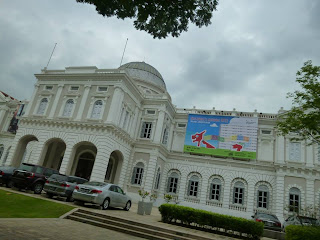 |
Many thanks to the invitation of the National Museum of Singapore, I had the pleasure to attend the launch of the DVD, Eat to Live: Wartime Recipes, in the morning of 7 Jun 2013 at the Gallery Theatre of the National Museum of Singapore. Member of Parliament, Christopher de Souze, was the Guest of Honour for the event.
The DVD, Eat to Live: Wartime Recipes, is commissioned by the National Museum of Singapore. It is directed and produced by local filmmakers Gozde and Russel Zehnder. The production is based on the book Wartime Kitchen: Food and Eating in Singapore 1942 - 1950 (2009, Editions Didier Millet Ptd Ltd and National Museum of Singapore). It reveals the practices of food rationing and the conditions of the unpredictable food supply during the Japanese Occupation in Singapore.
 |
| National Museum of Singapore. Taken in May 2013. |
The Question and Answer session with the filmmakers gave me a glimpse of the challenges that were faced when producing this DVD. Perhaps one of the greatest challenges was finding willing and living interviewees who have experienced the Japanese Occupation of Singapore. I learnt that a few of the interviewees who had been interviewed for the book Wartime Kitchen: Food and Eating in Singapore 1942 - 1950 had passed on by the time the production team started filming for Eat to Live: Wartime Recipes. It seemed even more critical to produce this documentary series as soon as we can so as to document a turbulent episode of history for future generations to remember.
Watching Eat to Live: Wartime Recipes reminded me that my generation is very blessed to live in a time when there is generally abundant access to food. During the Japanese Occupation of Singapore from 1942 to 1945, the common people has to cope with food rationing and limited food supply. As I watched the documentary series, I feel grateful that I have everything that I need in my life.
Interesting, I realized that we in Singapore have been quite dependent on sources of food which are exported from outside Singapore. The documentary series reminded me that we as a community will have to start thinking about how we can produce sufficient food for everyone in a sustainable way. I realized that I am lacking in the knowledge and skills to grow my own food should circumstances necessitate it. How does it feel to be close to the land? How could I grow food crops such as tapioca, kang kong and papaya?
This is a meaningful documentary series to collect. It reminded me of the turbulent times that people have to overcome during the Japanese Occupation. I was reminded not to take food and the peace we have for granted.
I watched each episode of the documentary in the comfort of my own home and was delighted by the care and attention that has been put in to make this documentary series possible. I very much like the idea of the six collectable recipe cards of wartime dishes. These recipes would have been hot favourites for aspiring chefs who would like to recreate these wartime dishes. The wartime dishes that were featured were:
- Tapioca Vadai,
- Kangkong and Sweet Potato Lemak,
- Sotong Masak Kiam Chye,
- Betik Masak Titek,
- Lobster a la Bystander and
- Baked Fish Custards.
It is fascinating to learn more about the Japanese Occupation by exploring the experience of food consumption during that period. With creativity and ingenuity, people have created interesting wartime recipes that kept them alive!
Eat to Live: Wartime Recipes is available for sale from major book stores such as Kinokuniya.
***
Also see:
Eat to Live - Wartime Recipes By Yesterday.sg
Eat to Live: Wartime Recipes (Episode 1: Food as Power and Control)
Eat to Live: Wartime Recipes

No comments:
Post a Comment